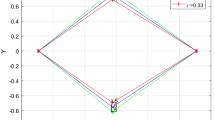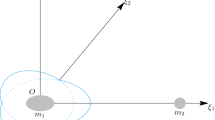Abstract
This paper presents the study of the perturbed restricted problem of three bodies with an elongated smaller primary and an oblate radiating bigger primary. The albedo effect and small perturbations in the Coriolis and centrifugal forces have also been considered. The equilibrium points of the system and their linear stability are elaborated, and the significant variation in equilibrium points and their stability is observed. It is observed that the critical value of mass parameter \(\mu _c\) increases due to all the considered parameters except oblateness and segment-length. It is found that the critical mass parameter \(\mu _c\) decreases due to the effect of segment-length and oblateness. In addition, periodic orbits are constructed in the neighbourhood of equilibrium points. The effects of perturbing parameters in the periodic orbits are studied. The Poincaré Surface Section is constructed and then used to produce periodic orbits associated with its resonance. Considerable impact on the zero velocity curves and the periodic orbits are observed near the elongated primary. These effects decrease when the infinitesimal particle moves farther away from the elongated primary.












Similar content being viewed by others
References
Abouelmagd, E.I., Asiri, H., Sharaf, M.: The effect of oblateness in the perturbed restricted three-body problem. Meccanica 48(10), 2479–2490 (2013)
Anselmo, L., Farinella, P., Milani, A., Nobili, A.M.: Effects of the earth-reflected sunlight on the orbit of the Lageos satellite. Astron. Astrophys. 117, 3–8 (1983)
Antoniadou, K.I., Libert, A.S.: Origin and continuation of 3/2, 5/2, 3/1, 4/1 and 5/1 resonant periodic orbits in the circular and elliptic restricted three-body problem. Celest. Mech. Dyn. Astron. 130(6), 1–30 (2018)
Arredondo, J.A., Guo, J., Stoica, C., Tamayo, C.: On the restricted three body problem with oblate primaries. Astrophys. Space Sci. 341(2), 315–322 (2012)
Bhatnagar, K., Hallan, P.: Effect of perturbations in Coriolis and centrifugal forces on the stability of libration points in the restricted problem. Celest. Mech. 18(2), 105–112 (1978)
Burgos-García, J., Delgado, J.: Periodic orbits in the restricted four-body problem with two equal masses. Astrophys. Space Sci. 345(2), 247–263 (2013)
Del Genio, A., Way, M., Amundsen, D., Sohl, L., Fujii, Y., Ebihara, Y., Kiang, N., Chandler, M., Aleinov, I., Kelley, M.: Equilibrium temperatures and albedos of habitable earth-like planets in a coupled atmosphere-ocean GCM. In: Habitable Worlds 2017: A System Science Workshop, GSFC-E-DAA-TN51079 (2017)
Douskos, C., Markellos, V.: Out-of-plane equilibrium points in the restricted three-body problem with oblateness. Astron. Astrophys. 446(1), 357–360 (2006)
Ghazy, M.A.: Analytic Construction of Periodic Orbits in the Restricted Three-Body Problem. Old Dominion University, Norfolk (2010)
Grøtte, M.E., Holzinger, M.J.: Solar sail equilibria with albedo radiation pressure in the circular restricted three-body problem. Adv. Space Res. 59(4), 1112–1127 (2017)
Harris, M., Lyle, R.: Spacecraft radiation torque. In: NASA Space Vehicle Design Criteria, vol. SP-8027 (1969)
Idrisi, M.J.: A study of libration points in modified CR3BP under albedo effect when smaller primary is an ellipsoid. J. Astronaut. Sci. 64(4), 379–398 (2017)
Idrisi, M.J., Ullah, M.S.: Non-collinear libration points in ER3BP with albedo effect and oblateness. J. Astrophys. Astron. 39(3), 1–10 (2018)
Idrisi, M.J., Ullah, M.S.: A study of albedo effects on libration points in the elliptic restricted three-body problem. J. Astronaut. Sci. 67(3), 863–879 (2020)
Jain, R., Sinha, D.: Stability and regions of motion in the restricted three-body problem when both the primaries are finite straight segments. Astrophys. Space Sci. 351(1), 87–100 (2014)
Kaur, B., Kumar, D., Chauhan, S.: Effect of perturbations in the Coriolis and centrifugal forces in the Robe-finite straight segment model with arbitrary density parameter. Astron. Nachr. 341(1), 32–43 (2020)
Kishor, R., Kushvah, B.S.: Linear stability and resonances in the generalized photogravitational chermnykh-like problem with a disc. Mon. Not. R. Astron. Soc. 436(2), 1741–1749 (2013)
Kishor, R., Kushvah, B.S.: Periodic orbits in the generalized photogravitational Chermnykh-like problem with power-law profile. Astrophys. Space Sci. 344(2), 333–346 (2013)
Kolemen, E., Kasdin, N.J., Gurfil, P.: Multiple poincaré sections method for finding the quasiperiodic orbits of the restricted three body problem. Celest. Mech. Dyn. Astron. 112(1), 47–74 (2012)
Kumar, D., Kaur, B., Chauhan, S., Kumar, V.: Robe’s restricted three-body problem when one of the primaries is a finite straight segment. Int. J. Non-Linear Mech. 109, 182–188 (2019)
Kumar, D., Aggarwal, R., Kaur, B.: An insight on the restricted problem of 2+2 bodies with straight segment. Astron. Nachr. 341(6–7), 669–683 (2020)
Kumar, D., Aggarwal, R., Kaur, B.: On the perturbed restricted 2+2 body problem when the primaries are non-spherical. Few-Body Syst. 62(4), 1–18 (2021)
Kushvah, B.S.: Linear stability of equilibrium points in the generalized photogravitational Chermnykh’s problem. Astrophys. Space Sci. 318(1), 41–50 (2008)
Lara, M.: On perturbation solutions in the restricted three-body problem dynamics. Acta Astronautica 195, 596–604 (2022)
Mahato, G., Kushvah, B.S., Pal, A.K., Verma, R.K.: Dynamics of the restricted three-body problem having elongated smaller primary with disk-like structure. Adv. Space Res. 69(9), 3490–3501 (2022)
Markellos, V., Papadakis, K., Perdios, E.: Non-linear stability zones around triangular equilibria in the plane circular restricted three-body problem with oblateness. Astrophys. Space Sci. 245(1), 157–164 (1996)
McCuskey, S.W.: Introduction to celestial mechanics. Addison-Wesley, Reading (1963)
Murray, C.D., Dermott, S.F.: Solar System Dynamics. Cambridge University Press, Cambridge (1999)
Pal, A.K., Kushvah, B.S.: Geometry of halo and Lissajous orbits in the circular restricted three-body problem with drag forces. Mon. Not. R. Astron. Soc. 446(1), 959–972 (2015)
Pathak, N., Thomas, V., Abouelmagd, E.I.: The perturbed photogravitational restricted three-body problem: Analysis of resonant periodic orbits. Discret. Contin. Dyn. Syst. S 12(4 &5), 849 (2019)
Riaguas, A., Elipe, A., López-Moratalla, T.: Non-linear stability of the equilibria in the gravity field of a finite straight segment. Celest. Mech. Dyn. Astron. 81(3), 235–248 (2001)
Rocco, E.M.: Evaluation of the terrestrial albedo applied to some scientific missions. Space Sci. Rev. 151(1–3), 135–147 (2010)
Ruth, Y.S., Sharma, R.: Periodic orbits in the photogravitational elliptic restricted three-body problem. Adv. Astrophys. 3, 154–170 (2018)
Simmons, J., McDonald, A., Brown, J.: The restricted 3-body problem with radiation pressure. Celest. Mech. 35(2), 145–187 (1985)
Szebehely, V.: Theory of orbits: the restricted three body problem. Academic Press, New York and London (1967)
Yousuf, S., Kishor, R.: Effects of the albedo and disc on the zero velocity curves and linear stability of equilibrium points in the generalized restricted three-body problem. Mon. Not. R. Astron. Soc. 488(2), 1894–1907 (2019)
Zotos, E.E.: Investigating the Newton-Raphson basins of attraction in the restricted three-body problem with modified Newtonian gravity. J. Appl. Math. Comput. 56(1), 53–71 (2018)
Acknowledgements
The third author is financially supported by the Council of Scientific and Industrial Research (CSIR), Govt. of India (File No. 09/085(0126)/2019-EMR-1). We are thankful to DST(SERB) Government of India (Project No.-DST(SERB)/(163)/2016-2017/506/AM) for using the computation facility. The fourth author is supported by Enhanced Seed Grant through Endowment Fund Ref: EF/2021- 22/QE04-07 from Manipal University Jaipur.
Author information
Authors and Affiliations
Corresponding author
Ethics declarations
Conflict of interest
The authors state that the publishing of this paper doesn’t include any conflict of interests.
A. Appendix
A. Appendix
1.1 A. 1. Polynomials of Collinear Equilibrium Points
1.2 A. 2. Terms Used for Non-collinear Equilibrium Points (\(\theta _{1,2}\))
Rights and permissions
Springer Nature or its licensor (e.g. a society or other partner) holds exclusive rights to this article under a publishing agreement with the author(s) or other rightsholder(s); author self-archiving of the accepted manuscript version of this article is solely governed by the terms of such publishing agreement and applicable law.
About this article
Cite this article
Verma, R.K., Kushvah, B.S., Mahato, G. et al. Perturbed Restricted Problem of Three Bodies with Elongated Smaller Primary. J Astronaut Sci 70, 13 (2023). https://doi.org/10.1007/s40295-023-00374-y
Accepted:
Published:
DOI: https://doi.org/10.1007/s40295-023-00374-y




